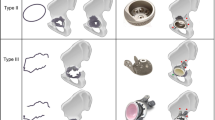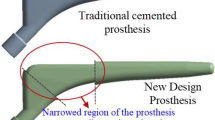Abstract
Introduction
The aim of this study is to compare the accuracy of acetabular cup positioning between the accelerometer-based navigation system and the augmented reality-based navigation system during THA in the supine position.
Materials and methods
This retrospective study included 66 patients (70 hips) who underwent THA using two types of portable navigation system, Hip Align or AR-Hip, in the spine position. The absolute difference between the intraoperative navigation record and postoperative measurement using computed tomography data was evaluated. Preoperative clinical factors that decreased the accuracy of cup positioning by ≥ 3° were analyzed via multiple logistic regression analyses.
Results
The average absolute error of inclination was 2.8 ± 2.6° in Hip Align and 2.7 ± 1.8° in AR-Hip, and absolute anteversion error was 2.5 ± 2.0° in Hip Align and 2.6 ± 2.2° in AR-Hip, and there was no significantly different between the two navigation systems. There was a significant association between the absolute measurement error (≥ 3°) of cup inclination and patients’ BMI in the Hip Align group [odds ratio (OR) 1.350; 95% confidence interval (CI) 1.035–1.760; p = 0.027], but not in the AR-Hip group.
Conclusions
The accuracy of the acetabular cup positioning between the Hip Align and AR-Hip showed no difference during THA in the spine position. The high BMI could have negative influence on the accuracy of cup positioning in THA using Hip Align, thus AR-Hip could be designable for obesity patients.


Similar content being viewed by others
Data availability
The data are available upon request from the corresponding author.
References
Hedlundh U, Fredin H (1995) Patient characteristics in dislocations after primary total hip arthroplasty. 60 patients compared with a control group. Acta Orthop Scand 66(3):225–228. https://doi.org/10.3109/17453679508995529
Kennedy JG, Rogers WB, Soffe KE, Sullivan RJ, Griffen DG, Sheehan LJ (1998) Effect of acetabular component orientation on recurrent dislocation, pelvic osteolysis, polyethylene wear, and component migration. J Arthroplasty 13(5):530–534. https://doi.org/10.1016/s0883-5403(98)90052-3
Asai H, Takegami Y, Seki T, Ishiguro N (2021) Pelvic tilt reduces the accuracy of acetabular component placement when using a portable navigation system: an in vitro study. Arthroplast Today 7:177–181. https://doi.org/10.1016/j.artd.2020.12.012
Kamenaga T, Hayashi S, Hashimoto S, Matsumoto T, Takayama K, Fujishiro T, Hiranaka T, Niikura T, Kuroda R (2019) Accuracy of cup orientation and learning curve of the accelerometer-based portable navigation system for total hip arthroplasty in the supine position. J Orthop Surg (Hong Kong) 27(2):2309499019848871. https://doi.org/10.1177/2309499019848871
Hayashi S, Hashimoto S, Takayama K, Matsumoto T, Kamenaga T, Fujishiro T, Hiranaka T, Niikura T, Kuroda R (2020) Evaluation of the accuracy of acetabular cup orientation using the accelerometer-based portable navigation system. J Orthop Sci 25(4):612–617. https://doi.org/10.1016/j.jos.2019.09.012
Tanino H, Nishida Y, Mitsutake R, Ito H (2020) Portable accelerometer-based navigation system for cup placement of total hip arthroplasty: a prospective, randomized, controlled study. J Arthroplasty 35(1):172–177. https://doi.org/10.1016/j.arth.2019.08.044
Okamoto M, Kawasaki M, Okura T, Ochiai S, Yokoi H (2021) Comparison of accuracy of cup position using portable navigation versus alignment guide in total hip arthroplasty in supine position. Hip Int 31(4):492–499. https://doi.org/10.1177/1120700020908788
Ogawa H, Hasegawa S, Tsukada S, Matsubara M (2018) A pilot study of augmented reality technology applied to the acetabular cup placement during total hip arthroplasty. J Arthroplasty 33(6):1833–1837. https://doi.org/10.1016/j.arth.2018.01.067
Ogawa H, Kurosaka K, Sato A, Hirasawa N, Matsubara M, Tsukada S (2020) Does an augmented reality-based portable navigation system improve the accuracy of acetabular component orientation during THA? A randomized controlled trial. Clin Orthop Relat Res 478(5):935–943. https://doi.org/10.1097/CORR.0000000000001083
Tsukada S, Ogawa H, Hirasawa N, Nishino M, Aoyama H, Kurosaka K (2022) Augmented reality- vs accelerometer-based portable navigation system to improve the accuracy of acetabular cup placement during total hip arthroplasty in the lateral decubitus position. J Arthroplasty 37(3):488–494. https://doi.org/10.1016/j.arth.2021.11.004
Widmer KH, Zurfluh B (2004) Compliant positioning of total hip components for optimal range of motion. J Orthop Res 22(4):815–821. https://doi.org/10.1016/j.orthres.2003.11.001
Hayashi S, Hashimoto S, Kuroda Y, Nakano N, Matsumoto T, Ishida K, Shibanuma N, Kamenaga T, Kuroda R (2021) Accuracy of cup position following robot-assisted total hip arthroplasty may be associated with surgical approach and pelvic tilt. Sci Rep 11(1):7578. https://doi.org/10.1038/s41598-021-86849-0
Hayashi S, Kuroda Y, Nakano N, Matsumoto T, Kamenaga T, Maeda T, Kuroda R (2022) Comparing the accuracy of three-dimensional mini-optical portable navigation and accelerometer-based portable navigation system for acetabular cup placement during total hip arthroplasty. Arch Orthop Trauma Surg. https://doi.org/10.1007/s00402-022-04583-2
Faul F, Erdfelder E, Lang AG, Buchner A (2007) G*Power 3: a flexible statistical power analysis program for the social, behavioral, and biomedical sciences. Behav Res Methods 39(2):175–191. https://doi.org/10.3758/bf03193146
Phan D, Bederman SS, Schwarzkopf R (2015) The influence of sagittal spinal deformity on anteversion of the acetabular component in total hip arthroplasty. Bone Jt J 97-b(8):1017–1023. https://doi.org/10.1302/0301-620X.97B8.35700
Vigdorchik J, Eftekhary N, Elbuluk A, Abdel MP, Buckland AJ, Schwardzkopf RS, Jerabek SA, Mayman DJ (2019) Evaluation of the spine is critical in the workup of recurrent instability after total hip arthroplasty. Bone Jt J 101-b(7):817–823. https://doi.org/10.1302/0301-620X.101B7.BJJ-2018-1502.R1
Abdel MP, von Roth P, Jennings MT, Hanssen AD, Pagnano MW (2016) What safe zone? The vast majority of dislocated THAs are within the lewinnek safe zone for acetabular component position. Clin Orthop Relat Res 474(2):386–391. https://doi.org/10.1007/s11999-015-4432-5
Buckland AJ, Vigdorchik J, Schwab FJ, Errico TJ, Lafage R, Ames C, Bess S, Smith J, Mundis GM, Lafage V (2015) Acetabular anteversion changes due to spinal deformity correction: bridging the gap between hip and spine surgeons. J Bone Jt Surg Am 97(23):1913–1920. https://doi.org/10.2106/JBJS.O.00276
Yamada K, Endo H, Tetsunaga T, Miyake T, Sanki T, Ozaki T (2018) Accuracy of cup positioning with the computed tomography-based two-dimensional to three-dimensional matched navigation system: a prospective randomized controlled study. J Arthroplasty 33(1):136–143. https://doi.org/10.1016/j.arth.2017.08.001
Hasegawa M, Naito Y, Tone S, Wakabayashi H, Sudo A (2021) Accuracy of acetabular cup insertion in an anterolateral supine approach using an accelerometer-based portable navigation system. J Artif Organs 24(1):82–89. https://doi.org/10.1007/s10047-020-01206-8
Kalteis T, Handel M, Bäthis H, Perlick L, Tingart M, Grifka J (2006) Imageless navigation for insertion of the acetabular component in total hip arthroplasty: is it as accurate as CT-based navigation? J Bone Jt Surg Br 88(2):163–167. https://doi.org/10.1302/0301-620X.88B2.17163
Fukunishi S, Nishio S, Fujihara Y, Okahisa S, Takeda Y, Fukui T, Yoshiya S (2016) Accuracy of combined anteversion in image-free navigated total hip arthroplasty: stem-first or cup-first technique? Int Orthop 40(1):9–13. https://doi.org/10.1007/s00264-015-2784-9
Kamenaga T, Hayashi S, Hashimoto S, Takayama K, Fujishiro T, Hiranaka T, Kuroda R, Matsumoto T (2020) Intraoperative pelvic movement is associated with the body mass index in patients undergoing total hip arthroplasty in the supine position. J Orthop Sci 25(3):446–451. https://doi.org/10.1016/j.jos.2019.05.010
Iwakiri K, Kobayashi A, Ohta Y, Minoda Y, Takaoka K, Nakamura H (2017) Efficacy of a pelvic lateral positioner with a mechanical cup navigator based on the anatomical pelvic plane in total hip arthroplasty. J Arthroplasty 32(12):3659–3664. https://doi.org/10.1016/j.arth.2017.06.033
DiGioia AM, Jaramaz B, Blackwell M, Simon DA, Morgan F, Moody JE, Nikou C, Colgan BD, Aston CA, Labarca RS, Kischell E, Kanade T (1998) The Otto Aufranc Award. Image guided navigation system to measure intraoperatively acetabular implant alignment. Clin Orthop Relat Res 355:8–22. https://doi.org/10.1097/00003086-199810000-00003
McKee MD, Waddell JP (1994) Intramedullary nailing of femoral fractures in morbidly obese patients. J Trauma 36(2):208–210. https://doi.org/10.1097/00005373-199402000-00011
Fasol R, Schindler M, Schumacher B, Schlaudraff K, Hannes W, Seitelberger R, Schlosser V (1992) The influence of obesity on perioperative morbidity: retrospective study of 502 aortocoronary bypass operations. Thorac Cardiovasc Surg 40(3):126–129. https://doi.org/10.1055/s-2007-1020129
Angrisani L, Lorenzo M, De Palma G, Sivero L, Catanzano C, Tesauro B, Persico G (1995) Laparoscopic cholecystectomy in obese patients compared with nonobese patients. Surg Laparosc Endosc 5(3):197–201
Gupta A, Redmond JM, Hammarstedt JE, Petrakos AE, Vemula SP, Domb BG (2015) Does robotic-assisted computer navigation affect acetabular cup positioning in total hip arthroplasty in the obese patient? A comparison study. J Arthroplasty 30(12):2204–2207. https://doi.org/10.1016/j.arth.2015.06.062
Hupel TM, McKee MD, Waddell JP, Schemitsch EH (1998) Primary external fixation of rotationally unstable pelvic fractures in obese patients. J Trauma 45(1):111–115. https://doi.org/10.1097/00005373-199807000-00024
Vaidya R, Kubiak EN, Bergin PF, Dombroski DG, Critchlow RJ, Sethi A, Starr AJ (2012) Complications of anterior subcutaneous internal fixation for unstable pelvis fractures: a multicenter study. Clin Orthop Relat Res 470(8):2124–2131. https://doi.org/10.1007/s11999-011-2233-z
Najjar MF, Rowland M (1987) Anthropometric reference data and prevalence of overweight, United States, 1976–80. Vital Health Stat 11(238):1–73
Hayashi S, Kuroda Y, Nakano N, Matsumoto T, Kamenaga T, Maeda T, Niikura T, Kuroda R (2022) Peri-prosthetic bone remodeling of hydroxyapatite-coated compaction short stem was not affected by stem alignment. J Orthop Surg Res 17(1):131. https://doi.org/10.1186/s13018-022-03022-7
Funding
This research did not receive any specific grant from funding agencies in the public, commercial, or not-for-profit sectors.
Author information
Authors and Affiliations
Contributions
All authors contributed to the present study equally.
Corresponding author
Ethics declarations
Conflict of interest
The authors declare that they have no conflict of interest.
Ethical approval
This article does not contain any studies with human or animal subjects performed by any of the authors.
Informed consent
For this type of study informed consent is not required.
Additional information
Publisher's Note
Springer Nature remains neutral with regard to jurisdictional claims in published maps and institutional affiliations.
Rights and permissions
Springer Nature or its licensor (e.g. a society or other partner) holds exclusive rights to this article under a publishing agreement with the author(s) or other rightsholder(s); author self-archiving of the accepted manuscript version of this article is solely governed by the terms of such publishing agreement and applicable law.
About this article
Cite this article
Fujita, M., Hayashi, S., Kuroda, Y. et al. Accuracy comparison of cup positioning during total hip arthroplasty using Hip Align and AR-Hip in the supine position. Arch Orthop Trauma Surg 143, 7229–7235 (2023). https://doi.org/10.1007/s00402-023-04975-y
Received:
Accepted:
Published:
Issue Date:
DOI: https://doi.org/10.1007/s00402-023-04975-y




